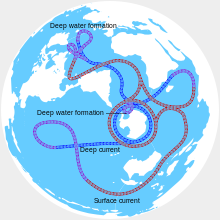Drake Passage
The Antarctic Circumpolar Current, which runs through it, meets no resistance from any landmass, and waves top 40 feet (12 m), giving it a reputation for being "the most powerful convergence of seas".
In 1525, Spanish navigator Francisco de Hoces discovered the Drake Passage while sailing south from the entrance of the Strait of Magellan.
After passing in 1578 through the Strait of Magellan with Marigold, Elizabeth, and his flagship Golden Hind, Drake entered the Pacific Ocean and was blown far south in a tempest.
[7] The Drake Passage opened when Antarctica separated from South America due to plate tectonics, however, there is much debate about when this occurred, with estimates ranging from 49 to 17 million years ago.
This opening could have been a primary cause of changes in global circulation and climate, as well as the rapid expansion of Antarctic ice sheets, because, as Antarctica was encircled by ocean currents, it was cut off from receiving heat from warmer regions.
The other two passages around the southern extremity of South America — the Strait of Magellan and the Beagle Channel — have frequent narrows, leaving little maneuvering room for a ship, as well as unpredictable winds and tidal currents.
This is important to the unimpeded eastward flow of the Antarctic Circumpolar Current, which carries a huge volume of water through the passage and around Antarctica.
Models have been run with different widths and depths of the Drake Passage, and consequent changes in the global oceanic circulation and temperature distribution have been analyzed:[12][15] It appears that the "conveyor belt" of the global thermohaline circulation appears only in presence of an open Drake Passage, subject to wind forcing.
[16] Regarding the global surface temperature, an open (and sufficiently deep) Drake Passage cools the Southern Ocean and warms the high latitudes of the Northern Hemisphere.
The isolation of Antarctica by the ACC (that can flow only with an open Drake Passage) is credited by many researchers with causing the glaciation of the continent and global cooling in the Eocene epoch.
It has been estimated that the diapycnal diffusivity in the Drake Passage is ~20 times the value immediately to the west in the Pacific sector of the Antarctic Circumpolar Current (ACC).
The relative shallowness and narrowness of the passage makes it particularly suitable to assess the validity of horizontally and vertically changing quantities (such as velocity in Ekman's theory[22]).






